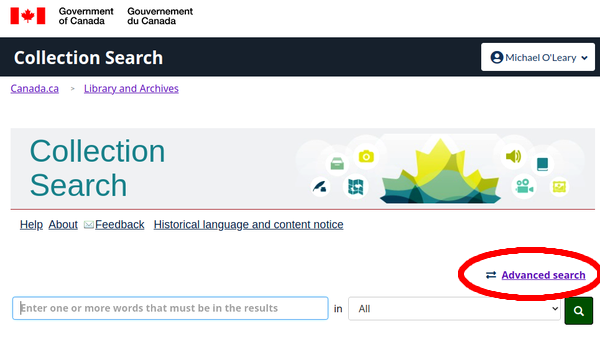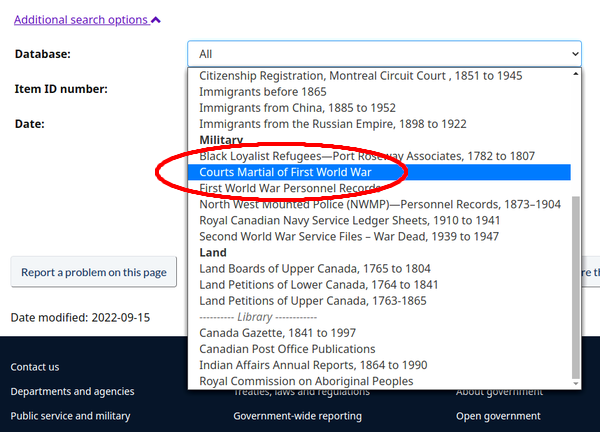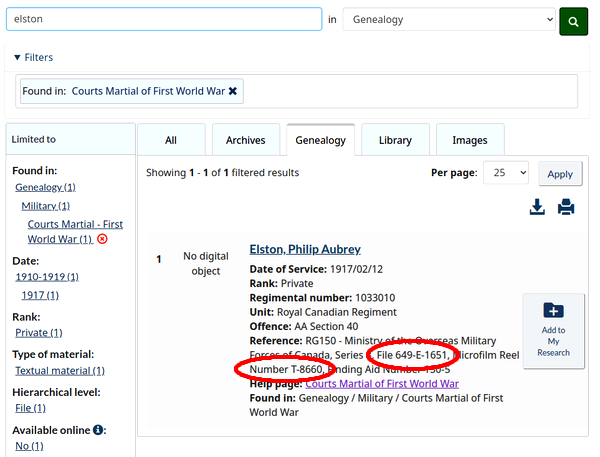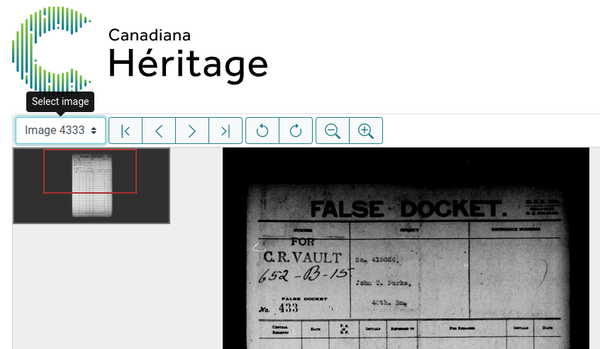
Researching Canadian Soldiers of the First World War
Part 3: Court Martial Records
By Michael O'Leary; The Regimental Rogue
Updated: 19 Sep 2022
While it may not be the best news to discover that your ancestor was court martialled during the First World War, it does present an advantage to researching the soldier's wartime experiences. Like the service records, court martial files have survived the threats of bureaucratic house-cleaning and are available through Library and Archives Canada (LAC). These records can be ordered, similar to service records, through the LAC website or found online in the microform reels under heritage.canadiana.ca at the Ministry of the Overseas Military Forces of Canada: Courts martial records, 1914-1919 (see the guidance below for these).
Even if you don't think your ancestor was court martialled, and there's no mention in his service record, it is still a worthwhile exercise to confirm with searches by name and service number.
With changes to the LAC website in September 2022, access to the Courts Martial records is through the general Collection Search page.

The basic search form for Collection Search at the Library and Archives Canada website.
From the Basic search form, open the Advanced Search.

The Adbvanced search form for Collection Search at the Library and Archives Canada website.
From the Database drop-down list, select "Courts martial of the First World War."

The database drop-down list, for narrowing the results of your search to the First World War Court Martial Records.
Enter the name (try starting with just the surname if it's not too common) of the soldier you are searching for. Including the CEF service number can help to narrow the search to the desired results.
This example search for Elston returned a single results of a court martial subject with that surname. For multiple returns, the service number or unit (at the time of the court martial) can help you identify the correct record.

An example of the result returned when searching on a soldier's surname (Elston)..
Note the "File number" and the "Microform Reel Number," you will need these to follow the directions below to find the digitized pages of the court martial record.
Military Offences
Military offences were identified by 'AA' for Army Act, followed by a number indicating the specific section of the Act under which the service person was charged. Some of these sections are summarized below:
- Offences in Respect of Military Service
- Section 4: the most serious military crimes, including deserting one's post, convincing a superior officer to surrender, throwing away one's arms in the presence of the enemy, assisting the enemy, corresponding with the enemy, or showing cowardice in the face of the enemy.
- Section 5: disobeying orders, failing to rejoin His Majesty's Forces after being released from an enemy prisoner of war camp, and spreading rumours that might cause fear and alarm amongst the troops.
- Section 6: a wide range of crimes including plundering, leaving one's post without orders, physically attacking another soldier, stealing from civilians; revealing secret passwords, being drunk at one's posts and making false alarms about attacks.
- Mutiny and Insubordination
- Section 7: leading and taking part in a mutiny, and refusing to report soldiers who were planning to mutiny.
- Section 8: striking or threatening a superior officer.
- Section 9: disobeying lawful orders from a superior officer.
- Section 10: resisting arrest.
- Section 11: refusing to obey a general order.
- Desertion, Fraudulent Enlistment, and Absence Without Leave
- Section 12: deserting or encouraging others to desert.
- Section 13: fraudulently enlisting in the forces, for example by lying about one's age.
- Section 14: assisting a person to desert, and failing to report a person whom one knew intended to desert.
- Section 15: being absent without leave.
- Section 16: behaving in a scandalous manner, unbecoming the character of an officer and a gentleman.
- Section 17: the fraudulent use of public or regimental funds.
- Section 18: "malingering", pretending to be ill or deliberately injuring yourself.
- Section 19: drunkenness.
- Offences in Relation to Persons in Custody
- Section 20: officers and men who had been given the task of guarding prisoners. Such men could be charged for releasing a prisoner without the proper authority; or allowing a prisoner to escape.
- Section 21: unnecessarily detaining someone without bringing his or her case to the proper authorities for investigation or trial.
- Section 22: attempting to escape from custody.
- Offences in Relation to Property
- Section 23: fraudulently selling government property or extracting exorbitant prices for goods and services.
- Section 24: selling, pawning, losing, or destroying arms, equipment, decorations and other public property as well as "ill-treating a horse used in the public service."
- Offences in Relation to False Documents and Statements
- Section 25: knowingly altering or making false statements on official documents.
- Section 26: falsely filling out documents or refusing to complete reports relating to arms, ammunition and equipment.
- Section 27: making false statements about the character of another officer or soldier and making false statements about one's own military career.
- Offences in Relation to Courts Martial
- Section 28: making false statements or refusing to answer questions on the witness stand, refusing to take an oath in court, refusing to produce documents when asked to do so by the court, and insulting or disrupting the court.
- Section 29: knowingly giving false evidence in court.
- Offences in Relation to Billeting
- Section 30: "billeting", the practice of soldiers' lodging in private homes while on active service. Service men and women could be charged for mistreating, threatening or refusing to pay householders for billeting troops.
- Offences in Relation to Impressment of Carriages
- Section 31: offences that occurred when service men forced civilians to hand over their horses and carriages without proper compensation.
- Offences in Relation to Enlistment
- Section 32: re-enlisting in the forces without declaring that one had been previously discharged in disgrace.
- Section 33: making false statements on an attestation paper.
- Section 34: helping a person to enlist fraudulently.
- Miscellaneous Military Offences
- Section 35: using traitorous or disloyal words against the sovereign.
- Section 36: disclosing the location of forces, bases or operations to the enemy.
- Section 37: stated that officers could be charged for striking or ill-treating soldiers, while both soldiers and officers could be charged for refusing to repay advances on their pay.
- Section 38: fighting, or assisting in a duel, and attempting to commit suicide.
- Section 39: refusing to help the civil authorities take custody of a service person who was accused of a crime.
- Section 40: acting to the prejudice of good order and military discipline.
- Section 41: courts martial could try soldiers for treason, murder, rape, manslaughter and a number of other civil offences when they occurred more than one hundred miles away from the nearest civilian court.
- Section 155: selling a promotion in His Majesty's Forces.
Accessing the Court Martial Records Online
Most CEF Court Martial Records can be found in this collection of microfilm reels on canadiana.ca: Ministry of the Overseas Military Forces of Canada: Courts martial records, 1914-1919.
Use the file reference to identify the correct reel. For example, 415026 Pte. J.T. Burke's 1916 court martial is referenced "File 652-B-15, Microfilm Reel Number T-8693".
In the above example, the reel number is T8693. The reel includes 5459 page images. Each court martial records is contained within a document labelled with the file number 652-B-15. These docket numbers are in order, but are not a consistent series. The "missing" docket numbers would have contained other subject files.
Choose a page in the reel and then one page at a time move to the page that identifies the docket number. Once you confirm whether you need to be ahead or behind that point, try again and narrow the range in which you need to look until you find the docket number that matches the subject of your search. From there, save the URL link for reference and also each of the page images for your research.

The labeled docket cover for the 1916 CEF court martial of 415026 Pte. J.T. Burke.
With the details for the individual record, files may also be ordered using the same system as for service records. These instructions are reproduced below:
How to View the Microfilm or Order a Copy
Once you have located a person, you may wish to view the microfilm. There are several options:
- The microfilm reels are digitized on Héritage.
- Visit Library and Archives Canada (LAC) to view the microfilm and obtain copies on-site.
- Hire a freelance researcher to visit on-site and obtain copies for you.
As for service records, files will cost 40 cents per page plus postage. Once the LAC has your order, either by letter, facsimile or through their on-line ordering system, it can take four to six weeks to receive the records. (This time can increase if they are backlogged, as they can be around Remembrance Day or other times when people's interest in researching their soldier ancestors is piqued. Ordering a digital copy may reduce your wait time.
Court martial files can be 12-40 pages, depnding on how many witnesses were heard and how much testimony was recorded. They will include all of the documents of the proceedings including witness statements as given to the court.
Part 4 - War Diaries and Unit Histories.
Researching Canadian Soldiers of the First World War
- Introduction
- Part 1: Find your Man (or Woman)
- Part 2: The Service Record
- Part 3: Court Martial Records
- Part 4: War Diaries and Unit Histories
- Part 5: Casualties
- Part 6: Researching Honours and Awards
- Part 7: Deciphering Battlefield Location Information
- Part 8: More Mapping Information
- Part 9: Matching Battlefield Locations to the Modern Map
- Part 10: Service Numbers; More than meets the eye
- Part 11: Rank, no simple progression
- Part 12: Medals; Pip, Squeak, Wilfred and the whole gang
- Part 13: Evacuation to Hospital
- Part 14: The Wounded and Sick
- Part 15: Crime …
- Part 16: … and Punishment
- Part 17: Battalions and Brigades, Companies and Corps
- Part 18: Photo Forensics: Badges and Patches
- Part 19: Veterans Death Cards
- Part 20: The Vimy Pilgrims (1936)

- The O'Leary Collection; Medals of The Royal Canadian Regiment.
- Researching Canadian Soldiers of the First World War
- Researching The Royal Canadian Regiment
- The RCR in the First World War
- Badges of The RCR
- The Senior Subaltern
- The Minute Book
- Rogue Papers
- Tactical Primers
- The Regimental Library
- Battle Honours
- Perpetuation of the CEF
- A Miscellany
- Quotes
- The Frontenac Times
- Site Map
QUICK LINKS
- Tomb of the Unknown Soldier
- Vimy Memorial
- Dieppe Cemetery
- Perpetuation of CEF Units
- Researching Military Records
- Recommended Reading
- The Frontenac Times
- RCR Cap Badge (unique)
- Boer War Battles
- In Praise of Infantry
- Naval Toast of the Day
- Toasts in the Army (1956)
- Duties of the CSM and CQMS (1942)
- The "Man-in-the-Dark" Theory of Infantry Tactics and the "Expanding Torrent" System of Attack
- The Soldier's Pillar of Fire by Night; The Need for a Framework of Tactics (1921)
- Section Leading; A Guide for the Training of Non-Commissioned Officers as Commanders and Rifle Sections, 1928 (PDF)
- The Training of the Infantry Soldier (1929)
- Modern Infantry Discipline (1934)
- A Defence of Close-Order Drill (1934): A Reply To "Modern Infantry Discipline"
- Tactical Training in the British Army (1901)
- The Promotion and Examination of Army Officers (1903)
- Discipline and Personality (1925)
- The Necessity of Cultivating Brigade Spirit in Peace Time (1927)
- The Human Element In War (1927)
- The Human Element In Tanks (1927)
- Morale And Leadership (1929)
- The Sergeant-Major (1929)
- The Essence Of War (1930)
- Looks or Use? (1931)
- The Colours (1932)
- Personality in Leadership (1934)
- Origins of Some Military Terms (1935)
- Practical Examination; Promotion to Colonel N.P.A.M. (1936)
- Company Training (1937)
- Lament Of A Colonel's Lady (1938)
- Morale (1950)
- War Diaries—Good, Bad and Indifferent
- Catchwords – The Curse and the Cure (1953)
- Duelling in the Army
- Exercise DASH, A Jump Story (1954)
- The Man Who Wore Three Hats—DOUBLE ROLE
- Some Notes on Military Swords
- The Old Defence Quarterly (1960)
- Military History For All (1962)
- Notes for Visiting Generals (1963)
- Hints to General Staff Officers (1964)
- Notes for Young TEWTISTS (1966)
- THE P.B.I. (1970)
- Standing Orders for Army Brides (1973)
- The Time Safety Factor (1978)
- Raids (1933)
- Ludendorff on Clerking (1917)
- Pigeons in the Great War
- Canadian Officer Training Syllabus (1917)
- The Tragedy of the Last Bay (1927)
- The Trench Magazine (1928)
- Billets and Batman (1933)
- Some Notes on Shell Shock (1935)
- Wasted Time in Regimental Soldiering (1936)
- THE REGIMENT (1946)
- The Case for the Regimental System (1951)
- Regimental Tradition in the Infantry (1951)
- The Winter Clothing of British Troops in Canada, 1848-1849
- Notes On The Canadian Militia (1886)
- Re-Armament in the Dominions - Canada (1939)
- The Complete Kit of the Infantry Officer (1901)
- The Canadian Militia System (1901)
- The Infantry Militia Officer of To-day and His Problems (1926)
- Personality in Leadership (1934)
- British Regular Army in Canada
- Battle Honours (1957)
- Defence: The Great Canadian Fairy Tale (1972)
- The Pig (1986)
- Standing Orders for the Fortress of Halifax, N.S.; 1908
- Medals and Badges - Fakes and Copies
- Army Punishments Part 1 - • Part 2
• C.A.R.O. No. 6719 - Campaign Stars, Clasps, The Defence Medal and the War Medal 1939-45
[an error occurred while processing this directive]
[an error occurred while processing this directive]